
The Cyperaceae are a family of graminoid (grass-like), monocotyledonous flowering plants known as sedges. The family is large, with some 5,500 known species described in about 90 genera, the largest being the "true sedges" genus Carex with over 2,000 species.

Rhynchospora colorata, also known as starrush whitetop, white star sedge and white-topped sedge, is a perennial sedge with white bracts, giving it the appearance of white petals with long, green points. It is native to southeastern North America, from Virginia west to New Mexico in the United States, and south into the Caribbean islands.

Rhynchospora is a genus of about 400 species of sedges with a cosmopolitan distribution. The genus includes both annual and perennial species, mostly with erect 3-sided stems and 3-ranked leaves. The achenes bear a beak-like tubercule and are sometimes subtended by bristles. Many of the species are similar in vegetative appearance, and mature fruits are needed to make a positive identification.

Rhynchospora alba, the white beak-sedge, is a plant in the sedge family, Cyperaceae. It is a tufted herbaceous perennial around 50 cm tall, with white inflorescences that flower in August. The fruit of the sedge is a small achene with a characteristic beak-like cap. It is dispersed by wind or falls by gravity, leading to individuals existing in tight clumps. The species favours wet, acidic and nutrient poor soils, thriving in Sphagnum-dominated bogs, but also peaty grasslands. As such it is often used as a positive indicator for bog and mire ecosystem health.

Quercus chapmanii, commonly referred to as the Chapman oak, is a species of oak that grows in the southeastern United States.
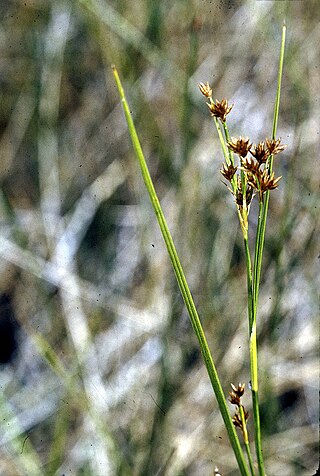
Rhynchospora capitellata is a species of sedge known by the common names brownish beaksedge and brownish beaked-rush. It is native to eastern North America and a few spots in the western United States. It grows in wet habitat, such as swamps, springtime meadows, and moist areas in forests. It is a perennial herb producing clumps of stems 20 to 100 centimeters tall, each stem sheathed with several narrow, pointed leaves. The inflorescence is a cluster of brown spikelets each about 3 or 4 millimeters long.

Pinguicula ionantha is a rare species of flowering plant in the butterwort family known by the common names Godfrey's butterwort and violet butterwort. It is endemic to the US state of Florida, where it only occurs in the central Florida Panhandle. It is threatened by the loss of its habitat, and it is a federally listed threatened species of the United States.

Rhynchospora knieskernii is a rare species of sedge known by the common name Knieskern's beaksedge. It is endemic to the state of New Jersey in the United States, where it occurs naturallyin the Pine Barrens. Reports have cited it present in Delaware as well, but these populations appear to have been introduced. It is threatened by the destruction and degradation of its habitat. It is a federally listed threatened species of the United States.
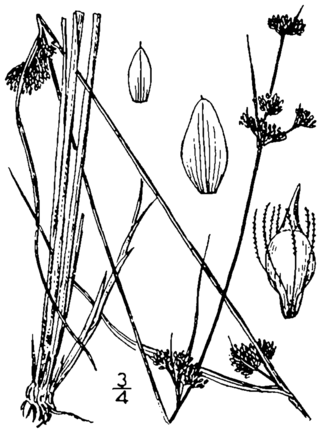
Rhynchospora capillacea is a species of sedge known by the common names needle beaksedge, slender beakrush and needle beakrush. It is native to eastern North America from Labrador to Alberta, and south to Texas. It grows in wet, usually calcareous habitat, such as fens, sandy or stony shores, interdunal flats, and wet meadows It is a perennial herb producing clumps of stems 10 to 40 centimeters tall, each stem with very narrow, filiform leaves. The inflorescence consists of few (1-4) narrow brown spikelets each about 6 or 7 millimeters long.

Kobuleti Strict Nature Reserve is a protected area in Kobuleti Municipality, Adjara region of Georgia along the Black Sea coast in the northern part of the resort town Kobuleti. Kobuleti Protected Areas were established in 1998 to preserve unique wetland ecosystems recognized by the Ramsar Convention. Because of these wetland ecosystems, ancient forests, and the high biodiversity found within the reserve, it was inscribed on the UNESCO World Heritage List as part of the Colchic Rainforests and Wetlands in 2021.
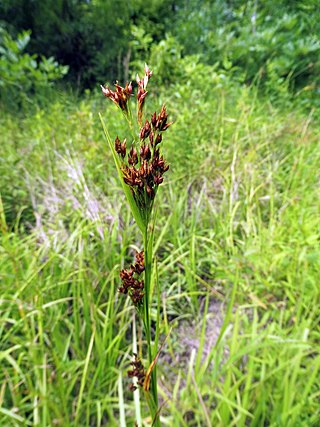
Rhynchospora caduca, commonly called anglestem beaksedge, is a species of flowering plant in the sedge family (Cyperaceae). It is native to North America, where it is found in the southeastern United States. Its typical natural habitat is in low, wet areas, such as in marshes, seeps, tidal swamps, pine savannas, and flatwoods.
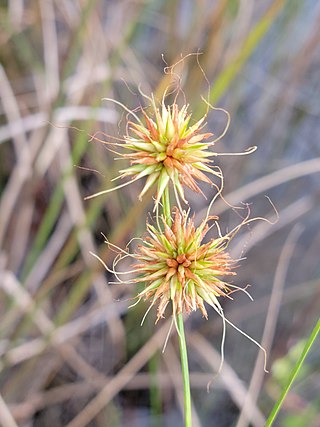
Rhynchospora tracyi, known by the common name of Tracy's beaksedge, is a member of the sedge family, Cyperaceae. It is a perennial herb, native to the Southeastern United States, the Bahamas, Cuba, Belize, and Honduras.

Rhynchospora corymbosa, known by the common names of golden beaksedge and matamat, is a member of the sedge family, Cyperaceae. It is a perennial herb, found globally throughout the tropics. It grows up to 2 meters tall in riverbanks, shallow pools, and swamps.

Rhynchospora rugosa, known by the common name of claybank beaksedge, is a member of the sedge family, Cyperaceae. It is a perennial herb, native to Central and South America.
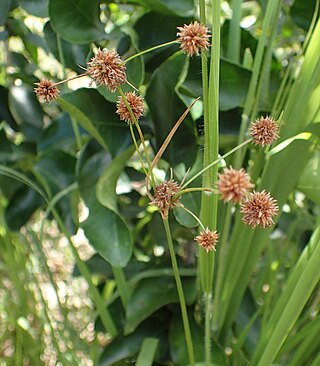
Rhynchospora holoschoenoides, known by the common name of fly beaksedge, is a member of the sedge family, Cyperaceae. It is a perennial herb, found throughout the Caribbean, Central and South America and western and southern Africa.
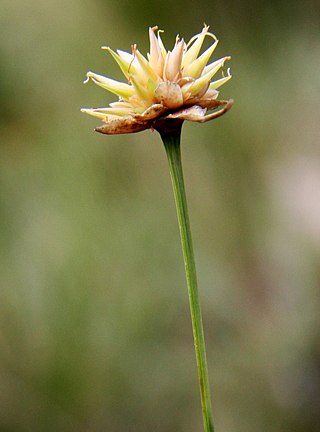
Rhynchospora globosa, known by the Spanish common name of estrellita de sabana, is a member of the sedge family, Cyperaceae. It is a perennial herb, found throughout the tropics of Central and South America. The variant R. globosa var. tenuifolia is endemic to Cuba.
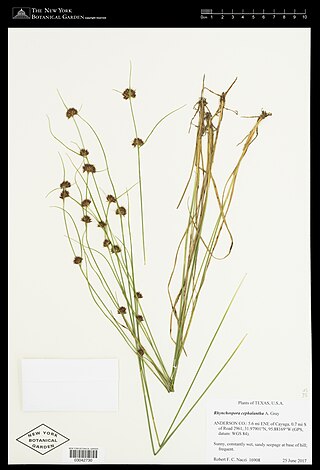
Rhynchospora cephalantha, known by the common name of bunched beaksedge, is a member of the sedge family, Cyperaceae. It is a perennial herb, found throughout the eastern United States, from New York to Texas.

Rhynchospora baldwinii, known by the common name of Baldwin's beaksedge, is a member of the sedge family, Cyperaceae. It is found in riverbanks and swampland near the coasts of the southeastern United States, as far west as New Orleans and as far north as Morehead City in North Carolina.

Rhynchospora careyana, known by the common name of broadfruit horned beaksedge, is a member of the sedge family, Cyperaceae. It is found in marshy areas near the Gulf coast of the southeastern United States, from western Louisiana to southeastern Georgia.
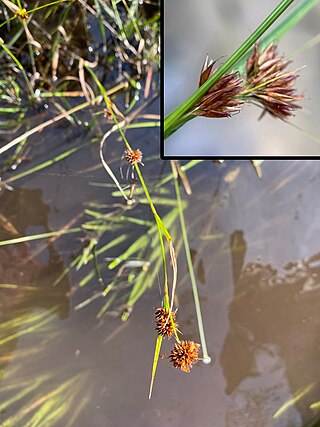
Rhynchospora chalarocephala, known by the common name of loosehead beaksedge, is a member of the sedge family, Cyperaceae. It is a perennial herb, found throughout the southeastern and Mid-Atlantic United States, from New Jersey to Texas.




















